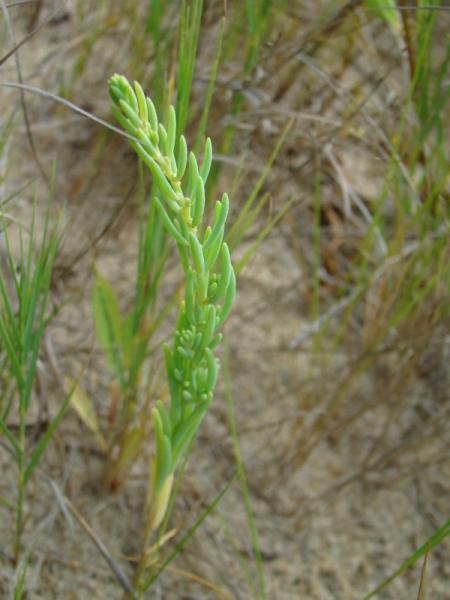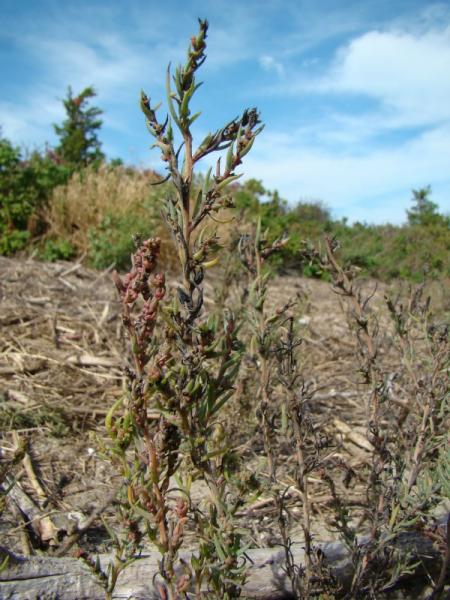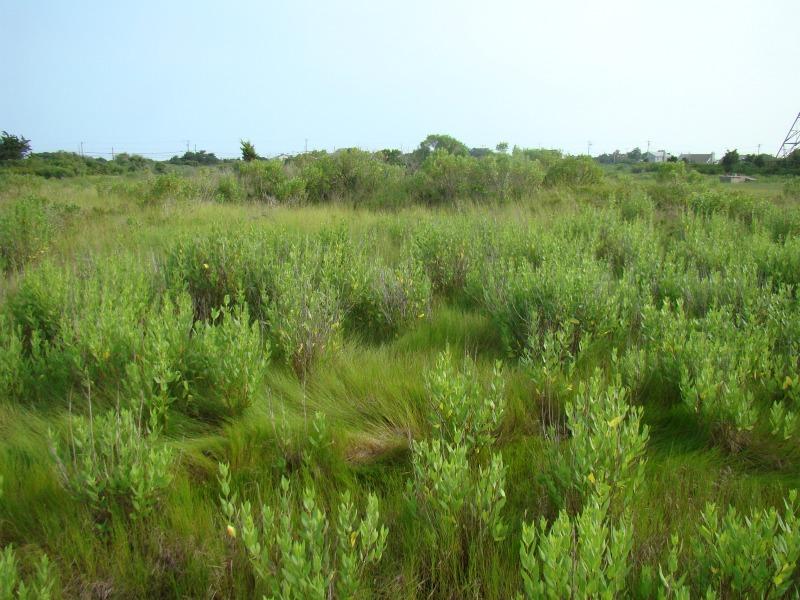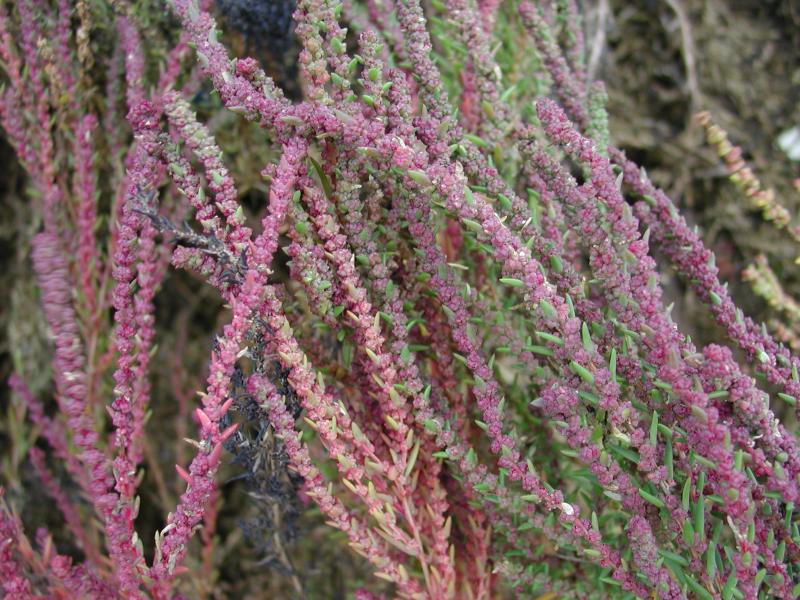Southern Sea Blite
Suaeda linearis (Ell.) Moq.
- Class
- Dicotyledoneae (Dicots)
- Family
- Amaranthaceae (Amaranth Family)
- State Protection
- Endangered
Listed as Endangered by New York State: in imminent danger of extirpation in New York. For animals, taking, importation, transportation, or possession is prohibited, except under license or permit. For plants, removal or damage without the consent of the landowner is prohibited.
- Federal Protection
- Not Listed
- State Conservation Status Rank
- S1S2
Critically Imperiled or Imperiled in New York - Especially or very vulnerable to disappearing from New York due to rarity or other factors; typically 20 or fewer populations or locations in New York, very few individuals, very restricted range, few remaining acres (or miles of stream), and/or steep declines. More information is needed to assign either S1 or S2.
- Global Conservation Status Rank
- G5
Secure globally - Common in the world; widespread and abundant (but may be rare in some parts of its range).
Summary
Did you know?
The genus name is the Arabic common name for this plant (Fernald 1950). Some species in the Southwestern United States were the source of a black dye used by Native Americans (Mabberley 1987).
State Ranking Justification
There are five existing populations but four of them have less than 50 plants each. Only one population is large with about 5000 plants. Two recent observations have not been confirmed. There are 19 populations from the early 1900s that have not been resurveyed and two that are considered extirpated.
Short-term Trends
Short-term trends seem stable but more revisits are needed to all populations to determine exact trends.
Long-term Trends
Even considering that this plant has always been rare in New York, there are apparently many fewer populations now than in the past, though many old records have not been resurveyed. The spread of Phragmites in New York's coastal salt marshes over the last 30 years has impacted Suaeda linearis, and in the absence of management will likely reduce or eliminate some populations.
Conservation and Management
Threats
Phragmites has been observed in the area of some populations and its continued spread could threaten populations.
Conservation Strategies and Management Practices
Natural buffers should be established around the salt marshes to decrease pollution runoff and other direct human disturbances. Phragmites invasions should be controlled in the salt marshes where they exist and new incursions prevented.
Research Needs
Research is needed to better understand the habitat requirements of this plant and determine why it is so rare even in large areas of seemingly suitable habitat.
Habitat
Habitat
In New York, Suaeda linearis has been found in a variety of maritime habitats near the high tide mark, including the upper edges of high salt marsh, interdunal swales with salt water influences, beaches, and trail or road edges (New York Natural Heritage Program 2011). Salt marshes, sandy beaches, other coastal wetlands (FNA 2003). Salt marshes and sea beaches primarily along the coast (Clemants 1992). Coastal salt-marshes (Gleason and Cronquist 1991). Sandy coast (Fernald 1970).
Associated Ecological Communities
- High salt marsh
(guide)
A coastal marsh community that occurs in sheltered areas of the seacoast, in a zone extending from mean high tide up to the limit of spring tides. It is periodically flooded by spring tides and flood tides. High salt marshes typically consist of a mosaic of patches that are mostly dominated by a single graminoid species.
- Maritime beach
(guide)
A community with extremely sparse vegetation that occurs on unstable sand, gravel, or cobble ocean shores above mean high tide, where the shore is modified by storm waves and wind erosion.
- Maritime freshwater interdunal swales
(guide)
A mosaic of wetlands that occur in low areas between dunes along the Atlantic coast; the low areas (swales) are formed either by blowouts in the dunes that lower the soil surface to groundwater level, or by the seaward extension of dune fields. Water levels fluctuate seasonally and annually. Sedges and herbs are usually the most abundant types of plants. These wetlands may be quite small (less than 0.25 acre).
Associated Species
- Agalinis purpurea (purple agalinis)
- Ammophila breviligulata (beach grass)
- Atriplex cristata
- Baccharis halimifolia (groundsel-tree)
- Carex straminea (straw sedge)
- Cephalanthus occidentalis (buttonbush)
- Cyperus polystachyos (many-spiked flat sedge)
- Distichlis spicata (salt grass)
- Limonium carolinianum (sea-lavender)
- Myrica pensylvanica
- Panicum virgatum (switch grass)
- Phragmites australis (old world reed grass, old world phragmites)
- Plantago maritima var. juncoides (seaside plantain)
- Pluchea odorata (salt marsh-fleabane)
- Prunus serotina
- Rhus copallinum
- Salicornia bigelovii (Bigelow's glasswort)
- Salicornia depressa (slender glasswort)
- Schoenoplectus americanus (chair-maker's bulrush)
- Solidago sempervirens (northern seaside goldenrod)
- Spartina patens (salt-meadow cord grass)
- Spartina pectinata (prairie cord grass)
- Suaeda calceoliformis (horned sea-blite)
- Suaeda maritima
- Suaeda rolandii (Roland's sea-blite)
- Teucrium canadense (American germander)
Range
New York State Distribution
This saltmarsh plant is currently known from Queens and Suffolk counties, with historical records to the north and west in Nassau County, Staten Island, the Bronx, and Westchester County.
Global Distribution
This saltmarsh plant grows along the Atlantic and Gulf coasts from Maine south to Florida and west to Texas.
Identification Comments
General Description
Suaeda linearis is an annual (in New York) herb species with erect or ascending stems and branches, growing up to 90 centimeters tall. The leaves are fleshy, narrowly linear and only 40 millimeter or less in length. The sepals are equal, narrowly keeled, and 1 to 2.5 millimeters wide, completely enclosing the seeds (FNA 2003). The seeds egg-shaped, black, and just 1.0 to 1.5 millimeters in diameter (Clemants 1992).
Best Life Stage for Proper Identification
Plants with mature fruits and seeds are best for positive identification.
Similar Species
Many of the Suaeda species superficially are similar to one another, but differ considerably when viewed microscopically and cytologically. Suaeda maritima and S. rolandii have larger seeds (1.5 to 2.0 millimeters in diameter) than those of S. linearis and S. calceoliformis. Suaeda linearis differs from S. caleoliformis by having uniformly keeled sepals; S. calceoliformis has 1 or 2 corniculate (horned) sepals with the others slightly keeled (Clemants 1992).
Best Time to See
Fruiting plants should be present from October into November.
- Fruiting
The time of year you would expect to find Southern Sea Blite fruiting in New York.
Southern Sea Blite Images
Images of Similar Species
Taxonomy
Southern Sea Blite
Suaeda linearis (Ell.) Moq.
- Kingdom Plantae
- Phylum Anthophyta
- Class Dicotyledoneae
(Dicots)
- Order Caryophyllales
- Family Amaranthaceae (Amaranth Family)
- Order Caryophyllales
- Class Dicotyledoneae
(Dicots)
- Phylum Anthophyta
Additional Common Names
- Narrow-leaved Sea Blite
- Sea-blite
Synonyms
- Dondia linearis (Ell.) Heller
- Salsola linearis Elliott
Additional Resources
Best Identification Reference
Clemants, Steven E. 1992. Chenopodiaceae and Amaranthaceae of New York State. Bulletin No. 485. New York State Museum. Albany, NY.
Other References
Bassett, I.J. and C.W. Crompton. 1977. The genus Suaeda (Chenopodiaceae) of Canada. Canadian Journal of Botany 56: 581-591.
Crow, Garrett E. and C. Barre Hellquist. 2000. Aquatic and Wetland Plants of Northeastern North America: A revised and enlarged edition of Norman C. Fassett's a Manual of Aquatic Plants. Volume One: Pteridophytes, Gymnosperms, and Angiosperms: Dicotyledons. The University of Wisconsin Press. Madison, Wisconsin. 536 Pages.
Fernald, M.L. 1950. Gray's manual of botany. 8th edition. D. Van Nostrand, New York. 1632 pp.
Flora of North America Editorial Committee. 2003. Flora of North America North of Mexico, Volume 4, Magnoliophyta: Caryophyllidae, Part 1. Oxford University Press, New York.
Gleason, Henry A. and A. Cronquist. 1991. Manual of Vascular Plants of Northeastern United States and Adjacent Canada. The New York Botanical Garden, Bronx, New York. 910 pp.
Holmgren, Noel. 1998. The Illustrated Companion to Gleason and Cronquist's Manual. Illustrations of the Vascular Plants of Northeastern United States and Adjacent Canada. The New York Botanical Garden, Bronx, New York.
Mabberley, D.J. 1987. The plant book: a portable dictionary of the higher plants. Cambridge University Press, Cambridge. 706p.
Mitchell, Richard S. and Gordon C. Tucker. 1997. Revised Checklist of New York State Plants. Contributions to a Flora of New York State. Checklist IV. Bulletin No. 490. New York State Museum. Albany, NY. 400 pp.
New York Natural Heritage Program. 2010. Biotics database. New York Natural Heritage Program. New York State Department of Environmental Conservation. Albany, NY.
New York Natural Heritage Program. 2024. New York Natural Heritage Program Databases. Albany, NY.
Reschke, Carol. 1990. Ecological communities of New York State. New York Natural Heritage Program, New York State Department of Environmental Conservation. Latham, NY. 96 pp. plus xi.
Weldy, T. and D. Werier. 2010. New York flora atlas. [S.M. Landry, K.N. Campbell, and L.D. Mabe (original application development), Florida Center for Community Design and Research http://www.fccdr.usf.edu/. University of South Florida http://www.usf.edu/]. New York Flora Association http://newyork.plantatlas.usf.edu/, Albany, New York
Links
About This Guide
Information for this guide was last updated on: November 7, 2011
Please cite this page as:
New York Natural Heritage Program. 2024.
Online Conservation Guide for
Suaeda linearis.
Available from: https://guides.nynhp.org/narrow-leaf-sea-blite/.
Accessed July 27, 2024.



